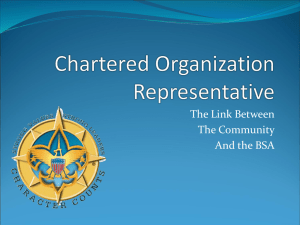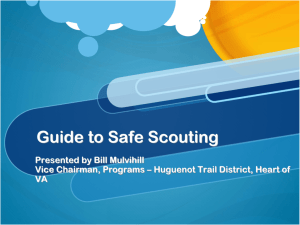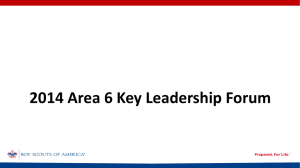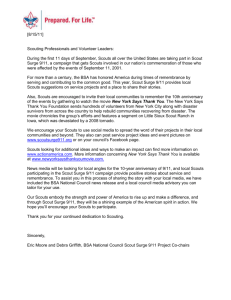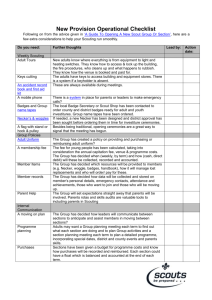Guide to Safe Scouting For Unit Activities
advertisement
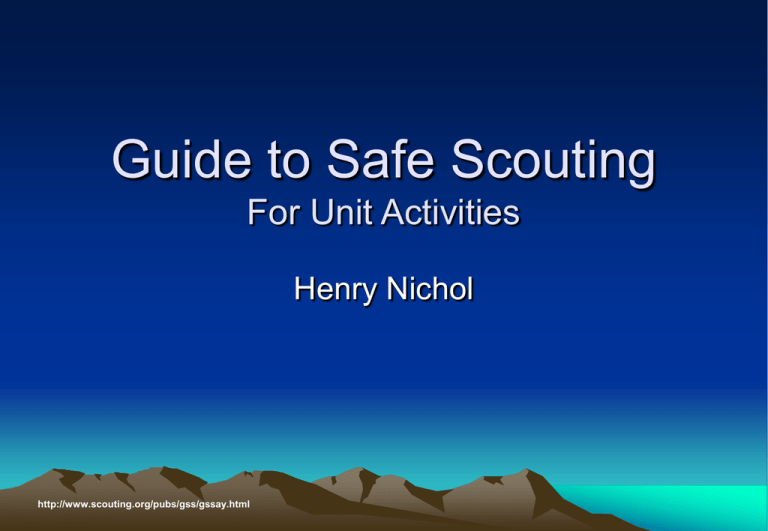
Guide to Safe Scouting For Unit Activities Henry Nichol http://www.scouting.org/pubs/gss/gssay.html Goal Setting • Why are you here? • What do you hope to learn? Purpose • To prepare Adult Leaders to Conduct Scouting Activities in a safe and prudent matter. • Established because of need to protect members from known hazards • Polices and guidelines are really there for safe and enjoyable adventures. • Unit leaders must be aware of state and local government regulations that supersede BSA policies How BSA and YOU going to do it? Agenda I. Youth Protection and Adult Leadership II. Aquatics Safety III. Camping IV. Drug, Alcohol, and Tobacco Use and Abuse V. Emergency Preparedness VI. First Aid VII. Fuels and Fire Prevention VIII. Guns and Firearms IX. Sports Activities X. Inspections XI. Medical Information XII. Transportation XIII. Winter Activities Youth Protection and Adult Leadership • Question - How Does BSA prevent child Abuse? • Answer - Policies that focus on leadership selection and placing barriers to abuse. • Question – How does BSA attract and train fabulous leaders • Answer - BSA works with Charter Organization to attract leaders and review applications BSA Barriers to Abuse Within Scouting • • • • • • • • • • Two deep Leadership No-one-on-one Contact Respect of Privacy Separate accommodations Proper preparation for high-adventure activities No secret organizations Appropriate attire Constructive Discipline Hazing Prohibited Youth leader training and supervision Parents Barriers to Abuse Within Scouting • If parents notice any deviations from BSA’s approved program, they should call these to the attention of the charter organization or unit committee • Parents should also read and review the booklet “How to Protect Your Children from Child Abuse and Drug Abuse: Parents Guide Other points • What do most child victims of sexual abuse keep the abuse secret? • What should I do if a child tells me that he has been sexually abused? • How do I know what my reporting responsibility are? • What youth protection education materials does the BSA have for youth members • How can scout leader who are not social workers teach children about youth protection • What are the “three R’s” of Youth Protection (recognize, resist, report) Three ‘R’s • What are the “three R’s” of Youth Protection (recognize, resist, report) Youth Member Behavior Guidelines • Follow the Scout Law and Oath. • Not acceptable – physical violence, hazing, bulling, theft, drugs and alcohol, corporal discipline. Leadership Requirements for Trips and Outings 1) 2) 3) 4) 5) 6) Two Deep Leadership Plan transportation Safety rule of four Male and female leaders separate sleeping Male and female participants separate sleeping Single room or dormitory-type accommodations for scouting units. 7) When stay in tent no youth will stay in tend of an adult other than his parent 8) Separate shower and latrine for gender and adult/scout 9) Two deep adult leadership is required for flying activities Not for display • Show yellow sheet in safe guide book and Age appropriate guidelines for scouting activities. If it is not listed do not do it till you consult with council Common Themes In Guide for Each Activity • • • • • Qualified Supervision Physical Fitness Safe area and equipment Buddy System Discipline What do scouts like to do? • • • • • Camp Hike Swim Fire Shoot • Lets talk about Swim next II. Aquatics Safety • • • • • • • • • • • • • • • • Instructors for Safe Swim Defense and Safety Afloat Training Safe Swim Defense Classification of Swimming Ability Pool and Surf Swimming Safety Afloat Personal Floatation Devices (PFDs) Water Clarity BSA Lifeguard Swimming Area Diving and Elevated Entry Scuba Policy Snorkeling Kayaking Waterskiing Boardsailing American Whitewater Safety Guidelines Instructors • Training is given by an approved individual by the council for the council – Safe Swim Defense – Safety Afloat Safe Swim Defense • Qualified Supervision – Trained in 8 points of BSA safe Swim Defense • Physical Fitness – Health History • Safe Area – Three groups (Annually verify level of swimmers) • Non swimmer - 3 ½ deepest • Beginners - just over head • Swimmers - not over 12 feet – Swimming is not permitted in water more than 12 feet deep. Safe Swim Defense (cont) • Lifeguards on Duty – Swim only where they are on duty. – If in unit swim area, where lifeguards are not provided, the supervisor should designate two capable swimmers as lifeguards. – Provide one lifeguard for every 10 people in water • Establish a look out on shore that can see all. It can be the adult in charge of the swim • Buddy System – Pair youth with one of same ability • Discipline – Each swimmer must know the Safe Swim Defense - Be strict and fair about these guidelines showing no favoritism. Classification of Swimming Ability • Swimmers test • Beginner test Pool and Surf Swimming • • • • Safe Swim Defense Public facility has a life guard, no need to post one. Buddy System is still important. Pool – • Adult supervision is still required to monitor and set guidelines Surf – – – Swimmers physical condition must be higher. Swimmer must be able to swim 5 minutes piously Area marked with flags easily seen Lifeguard to swimmer is no larger than 1-10 Safety Afloat • Adult leader must have completed the Safety Afloat Training no 34159C, have a card no 34242A with them and is dedicated to full compliance with all nine points of Safety Afloat. • What are the nine points? Nine Points • • • • • • • • • Qualified Supervision Physical Fitness Swimming Ability Personal Floatation Equipment Buddy System Skill Proficiency Planning Equipment Discipline • Personal Floatation Devices (PFD’s) – US Coast Guard-approved personal floatation device (PFD) must be worn at all times • Water Clarity – Turbid water should be limited to surface swimming – Snorkeling and scuba skills only practiced in clear water • BSA Lifeguard – 14 years of age or 8th grade – Completed the BSA Lifeguard course • Swimming Area – Minimum of 40 square feet per swimmer – Areas as stated before Diving and Elevated Entry • • • • Most dangerous No entry at a depth greater than 12 feet Feet first if dept is less than 7 feet Diving must be in 7 feet clear water but entry must be no higher than 18 inches from water • Diving must be in 9 feet clear water but entry no higher than 40 inches from water • Board diving must be mounted on a fixed platform no higher than 40 inches from water, no activity on at least 15 feet either side of board. Scuba Policy • Must be certified by or trained by – National Association of Underwater Instructors (NAUIO) – Professional Association of Diving Instructors (PADI) – Scuba Schools International (SSI) – Or Council approved organization • Cub Scouts not authorized • Other Scouts must be 14 years of age Snorkeling • Safe Swim Defense guidelines • Instructors – – • National Association of Underwater Instructors (NAUIO) Professional Association of Diving Instructors (PADI) Snorkeling Safety 1. 2. 3. 4. 5. 6. 7. 8. Qualified Supervision Physical Fitness Safe Area Proper Equipment Lifeguards/lookouts Ability Buddy System Discipline Kayaking • • Limited to Boy Scouts, Varsity Scouts, Ventures Kayaking Safety 1. 2. 3. 4. 5. 6. 7. 8. 9. Qualified Supervision Physical Fitness Swimming Ability Personal floatation equipment Buddy System Skill Proficiency Planning Equipment Discipline Water Skiing • • • • Safe equipment, competent instruction Efficient and careful tow boat operator and observer Follow Water Sports Safety Code Limited to Boys Scouts, Varsity and Venture Board Sailing • See Boardsailing BSA Award Application no 19-1935 American Whitewater Safety Guidelines • Be a competent Swimmer • Wear a Personal Floatation Device • Wear a Solid, Correctly Fitted Helmet • Keep Your Boat under Control • Be Aware of River Hazards III. Camping • • • • • • • • • Age Guidelines Family Camping Cub Scout Overnight Opportunities Trail Safety Beware of Lightning Treated Drinking Water BSA Property Smart Hantavirus Rabies Prevention Age Guidelines • Tiger, Wolf and Bear den not approved by BSA for Den Overnights • Tiger may participate in boy-parent excisions (family camping) • Wolf Bear and Webolus may participate in resident overnight camping program • Webolus may camp with troop. Den leader, pack leaders and parents are expected to join scout on trip. • Boy Scouts and varsity Scouts 12-17 are eligible to participate in national jamborees. • Boy Scouts and varsity Scours 13-17 are eligible to participate in world jamborees. Family Camping vs. Recreation Family Camping • Family Camping is an outdoor camping experience, other than resident camping, that involves Scouting program elements in overnight setting with two or more family members, including at least one BSA member of that family. Parent are responsible for supervision of their children and Youth Protection guidelines apply • Recreation Family Camping is when Scouting families camp as a family unit outside of an organized program. It is non structured camping experience, but is conducted within a Scouting framework on local council-owned or managed property Cub Scout Overnight Opportunities • Council Organized Family Camp – Overnight events involving more than one pack but sponsored by council – Overnight events involving more than one pack must be approved by the council • Pack Overnighters – Overnight events involving more than one family from a single pack focus on Cubs Scout appropriate activities. – At lease one Adult on a pack overnight must have completed BALOO training. Trail Safety 1. 2. 3. 4. 5. 6. 7. Qualified Supervision Keep Fit Plan Ahead Gear Up Communicate Clearly and Completely Monitor Conditions Discipline Beware of Lightning • • • • • • • • Stay away of from open doors/windows, fireplaces, metal stuff Do not use hair dryers, electric toothbrush/razor, phones Do not take clothes down Do not work outside Do not handle flammable material Do not play golf, fish Avoid high ground Avoid isolated trees. Treated Drinking Water • • • • A large supply is necessary If not sure, do not take a chance Treat Questionable water Filter Water – – – – Boil water for a minute Add 8 drops of liquid Chlorine Bleach Let stand 30 minutes If smell like Chlorine it is ok, else do it again, if still bad discard Note: you can do cold water, but it takes 4 times as long Miscellaneous • BSA Property Smart – Every one has the responsibility / obligation to do his or her best to care for and protect every property that he or she visits. • Hantavirus – identified in 30 states. Spread through the urine and feces of infected rodents. An airborne virus • Rabies Prevention – 7,000 animals a year, over 22,000 exposed or infected people IV. Drug, Alcohol & Tobacco Use & Abuse V. Emergency Preparedness • Emergency Preparedness PLAN • Emergency Preparedness KIT Emergency Preparedness PLAN • • • • • • • • • Plan ahead Recognize Alarm sound Agree on outdoor meeting place Everyone can call 911 and post other emergency numbers. Post address near phones Plan out of town routes Practice evacuating twice a year Practice natural disaster In emergency keep calm, stay together and explain to younger members what might happen next. Emergency Preparedness KIT • • • • • • • • • • • • • • Water – 1 gallon per person per day Food – non perishable. Flashlight (extra batteries First aid kit Medications Battery operated Radio Tools Clothing Personal items Sanitary supplies Money Contact information Pet supplies Map Note in BSA Guide page 27 is a Emergency Contact list VI. First Aid • It is important at least one person trained in first aid • First Aid kits (stocked and easy to get too) • Cardiopulmonary Resuscitation can be taught to Boy Scout and Venture Scout (Not recommend to Cub Scout) by American Heart Association. Preliminary skills related CPOR are found in Scout Handbook and the First Aid Merit badge. • Protection Considerations for Blood borne Pathogens – treat all individuals as though the blood is contaminated. • Near-Drowning – after a victim has recovered at the scene, take to hospital. Reactions can happen latter due to the recovery process, (lung rupture, pneumonia, and hypothermia) VII. Fuels and Fire Prevention • Chemical Fuels – use of liquid fuels is prohibited. • Guidelines for Safely Using Chemical Stoves and lanterns • Flammability Warning • Extinguishers – Class A - wood, fabric, etc. – Class B – Gasoline, oil, etc. – Class C – electrical • Fireworks – prohibited unless a licensed Fireworks Specialist manages the function VIII. Guns and Firearms • BSA adheres to policy of teaching safe, responsible , intelligent handling, care and use of fire arms. • Cub Scouting Standards - is only allowed Archery and BB gun shooting restricted to day camps, Cub Scout/Webelos Scout resident camps, and Council/managed activities. • Boys Scouting Standards – may participate in Shotgun, Muzzle Loaders, Rifles with the appropriate safety measures taken, Including an NRA Instructor. • Venture Standards – May shoot a hand gun with appropriate safety measures and an NRA Instructor. • Cannons and Large-bore artillery – not allowed IX. Sports Activities • • • • • • • • • • • • • • • Sweet 16 of BSA Safety Caving Judo, Tai Chi and Aikido Climbing and Rappelling Project COPE Activities Unauthorized and Restricted Activities Carbon Tetrachloride Knives Rope Monkey Bridges Parade Floats and Hayrides Unit Fund-raisers Tractor Safety Bike Safety Skating Guidelines Horsemanship Activities Note - Lets just review Sweet 16 Sweet 16 of BSA Safety These 16 points embody good judgment and common sense and apply to all activities. 1. 2. 3. 4. 5. 6. 7. 8. 9. 10. 11. 12. 13. 14. 15. 16. Qualified Supervision Physical Fitness Buddy System Safe area or Course Equipment Selection and Maintenance Personal Safety Equipment Safety Procedures and Policies Skill Level Limits Weather Check Planning Communications Permits and Notices First Aid Resources Applicable laws CPR resources Discipline X. Inspections • Meeting rooms inspect for health and safety • Motor vehicles • Unit Camping - Before set up, after take down and in between • Boats – U.S. Coast Guard can do upon request a marine examination of any craft. XI. Medical Information • Class 1 – event not exceed 72 hours • Class 2 – event exceeds 72 hours • Class 3 – Any event involving strenuous activity also if an adult is age 40+ • High Adventure Medical forms – Phillmont Scout Ranch and Florida Sea base require a special form for youth and adults • Immunization • Life-Threatening Communicable Diseases – a scout can continue in a Lone Scout Program • • Sun Safety Religious Beliefs and Medical Care – is required for all camp attendance except if it is waived due to religious beliefs – All must learn first aid to service others – Requirements 1-5 of Personal Fitness merit badge may be waived with proper church wavier • Prescriptions – Responsible of individual unless agreed to by Scout leader or guardian XII. Transportation • • • • • • • Automobiles Campers, Trailers and Trucks Buses Trains Boats Aircraft Tour Permits • • • Local National Commercial Driver’s License Compliance XIII. Winter Activities • Leadership • Equipment • Physical Conditions Conclusion • Have fun safely Scouting • Thanks for allowing me this time to share. • hnichol@kw.com 972-365-6731

